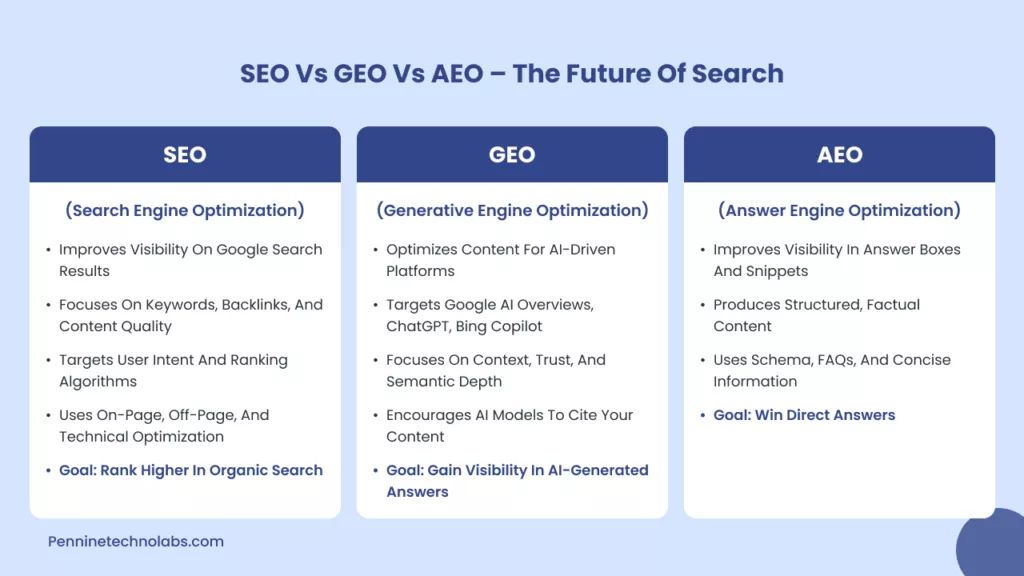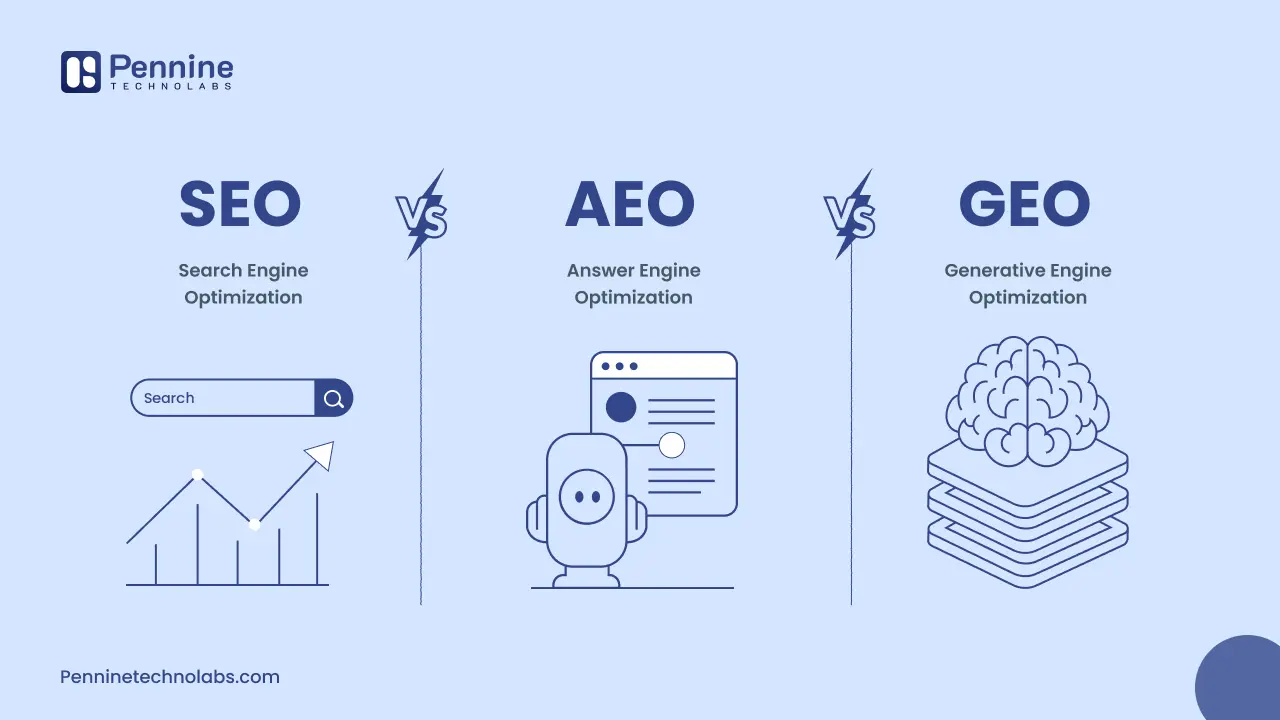Quick Summary: Search is no longer about keywords. As Google AI Overview and chat-based search engines such as ChatGPT define how individuals find information, companies have to go beyond SEO and add GEO and AEO to have actual visibility. Read about how each strategy works, highlights their differences, and demonstrates why relying solely on traditional SEO is no longer sufficient. Learn how to optimize your content for search engines, answer engines, and generative AI to stay ahead.
A Brief Introduction
The way people search online is changing rapidly. Traditional SEO is no longer enough if you aim to appear in today’s multi-level search experiences, such as Google’s AI overview or voice assistant. Now, new practices such as GEO (Generative Engine Optimization) and AEO (Answer Engine Optimization) are emerging with users.
According to a report by BrightEdge, over 58% of web traffic is affected by AI answer-based snippets. At the same time, 42% of brands noticed a change in traffic due to the results of generative AI Search Optimization. This difference is changing how the content should be made, structured, and optimized. (BrightEdge, 2024)
Let’s explore the core concepts of SEO, GEO, and AEO, including how each works and their significance for the future of search.
Shift in Search Behavior: Why Traditional SEO Alone Isn’t Enough
In the past, SEO primarily focused on keyword rankings, backlinks, and Google’s organic search results, commonly referred to as “Blue Links.” Today, users want immediate, relevant answers, whether through the AI Snapshot, the snippets, or voice assistants.
With Google Gemini, Bing Copilot, and platforms like Perplexity.ai offering direct, summarized answers, users often skip traditional results. Search engines are evolving beyond being answer engines and generative platforms, prompting businesses to reassess their strategies.
Search evolution in 2025 means that relying solely on SEO no longer guarantees visibility or clicks.
What is SEO?
SEO, or search engine optimization, organic search engine results, is the process of improving your website’s visibility in search engine results. It is about making your content search, relevant, and reliable in the eyes of search engines such as Google, Bing, and others. The goal is to rank high for the search queries that your audience is already searching for, so they find your content before your competitors. ,
SEO Development in India ensures that when someone discovers the product, service, or information you offer, your website shows prominently in the search results.
Why SEO Matters
More than 93% of online experiences begin with a search engine(WebFX), and over 68% of clicks go to the first five organic results on Google (Backlinko, 2024). This means that if your website is not ranking well, then you are losing visibility, traffic, and possible business every day.
Key Elements of SEO
SEO is not a single action but a combination of many ongoing strategies that align your website with the search engine algorithms. The main components include:
1. On-Page SEO
It focuses on customizing the content and structure within your website. This includes:
- Writing keywords targeted content that matches user intent
- Using optimized meta titles and Descriptions
- Structure Content with appropriate Heading tags(H1, H2, H3)
- Internal-linking with related pages
- Optimizing images with alt tags
- Mobile-friendly, fast-loading design
2. Technical SEO
These are the backend optimizations that help the search engine crawl, index, and understand your website:
- Clean URL structure and site architecture
- Sitemap and robots.txt configuration
- Page Speed and Core Web Vitals
- SSL Certificate for Safe Browsing (HTTPS)
- Fix crawl errors and broken links
3. Off-Page SEO
Off-page SEO focuses on building the right of your website and relying on external signals, such as:
- Backlinks from other prestigious websites
- Mention of an online brand
- Social Sharing and Reputation Management
- Guest Blogging and Digital PR Efforts
4. Content SEO
High-quality content is the backbone of a successful SEO strategy. Content involves making value-powered, original content:
- Answer user questions
- Uses keywords naturally and effectively
- Demonstrates expertise and reliability
- The user encourages engagement and shares
How Does SEO Work?
Search engines, such as Google, use complex algorithms to determine which pages are displayed for each search query or keyword. These consider hundreds of factors to rank algorithm pages. SEO helps to align your website with those ranking signals so that the search engines can do the following:
- Search your pages (through crawling)
- Understand what they are about (via indexing)
- Decide when to show them (based on relevance and quality)
It is about providing both users and search engines with what they need. If your site is navigable and full of fast, safe, and content-rich material, then you are already speaking Google’s language.
Examples of SEO in Action
- A local bakery adaptation for “Best Cupcakes” to appear in local search results
- A SaaS company creating a blog post that addresses pain-point questions, such as “to reduce the churning rate.”
- To appear in an e-commerce site’s rich results, optimize product pages with structured data to enhance their visibility.
- A digital marketing agency earns backlinks by contributing views to popular industry blogs.
Popular Tools for SEO
- Google Search Console – To monitor site performance and indexing
- Ahrefs – For backlink analysis, keyword research, and content audits
- SEMRush – To track rankings, perform competitor research, and identify SEO issues
- Moz Pro – Offers keyword tracking, site audits, and page optimization suggestions.
- Screaming Frog – A powerful crawler for technical SEO audits
- Yoast SEO – A popular WordPress plugin to optimize content for search engines
What is AEO?
AEO (Answer Engine Optimization) focuses on creating easily searchable and understandable materials. It is not only about the ranking but also about being chosen by AI to provide direct answers, especially in snippets, voice results, or AI-generated summaries.
How does AEO work?
AEO works by structuring the content in a way that allows AI to extract precise, reliable, and concise information. It also includes:
- Question-answer formats
- Adding Schema and structured data
- Focus on entities and relationships
- Optimizing for E-E-A-T (Experience, Expertise, Authority, Trust)
Examples of AEO
- Creating FAQ sections that answer specific user intents
- Using structured data like FAQPage, HowTo, or Product Schemas
- Adding clear subheadings and direct answers within your content
- Publishing authoritative, concise content
- Content for ChatGPT results and Google AI overview optimization from competitors analysis
Popular Tools for AEO
- Google’s Structured Data Testing Tool
- Schema.org
- Answer The Public
- AlsoAsked.com
- Surfer SEO (for content structuring)
What is GEO?
GEO (generative engine optimization) is the practice of optimizing content for AI-generated responses, as seen in Google’s AI overview, Bing Copilot, ChatGPT search, and Perplexity. It ensures that your brand and content are mentioned or quoted by these AI systems when users search for them.
Generation engine Optimization tools and strategies
- Writing deeply contextual, source-backed, conversational content
- Targeting long-tail and natural language queries
- Being cited by authoritative platforms and niche websites
- Publishing thought-leadership content and original data
- Optimizing for AI indexers (not just crawlers)
Examples of GEO
- Creating evergreen content that answers multiple related intents
- Writing articles that synthesize data and insights, not just list keywords
- Being cited in AI-generated summaries for queries like “best CRM tools for agencies”
- Optimizing for ChatGPT plugins or Perplexity data sources
GEO vs SEO vs AEO: What Are the Similarities and Differences?
Similarities
- All three aim to improve content visibility
- Content quality and authority matter across the board.
- Structured, user-focused content is key.
- E-E-A-T principles apply to all
- Keyword research remains relevant (but differently applied)
Differences Table: SEO vs AEO vs GEO
| Criteria | SEO | AEO | GEO |
|---|---|---|---|
| Full-Form | Search Engine Optimization | Answer Engine Optimization | Generative Engine Optimization |
| Primary Objective | Improve rankings in traditional search engine results | Get selected as the best answer for direct, voice, or snippet-based queries | Get cited or referenced in AI-generated responses and overviews |
| Optimized For | Search engine crawlers and ranking algorithms | AI-driven answer engines like Google Snippets, Alexa, Siri | Generative AI engines like Google SGE, Perplexity, ChatGPT, Bing Copilot |
| Content Structure | Keyword-targeted content with optimized headers and metadata | Clear, concise Q&A-style content with structured data | Contextual, analytical, and human-like responses meant to educate or summarize |
| Ranking Signals | Backlinks, keyword density, content freshness, UX, mobile-friendliness | Schema markup, content clarity, E-E-A-T, structured responses | Citation from credible sources, topical authority, trustworthiness of data |
| Content Tone | Informative and promotional, depending on the purpose | Direct, concise, and fact-driven | Natural, conversational, explanatory, with citations or sourced perspectives |
| Type of Answer Provided | User reads and evaluates multiple search result options | Instant answers pulled from your content (snippets, voice, FAQs) | AI-written summaries that may reference or rewrite your original content |
| Visibility Location | Search engine results pages (SERPs), including Google, Bing | Featured Snippets, Knowledge Panels, Voice Assistant answers | AI search platforms and LLM-powered results, including Google’s AI Overviews |
| Data Dependency | Search engine index and link graph | Structured data, schema markup, and entity recognition | AI datasets, prompt engines, citation networks, and contextual understanding |
| Core Optimization Activities | On-page SEO, link building, technical fixes, UX improvements | Implementing structured data, formatting for snippets, optimizing for clarity | Creating source-backed content, long-form explanations, AI-prompt awareness |
| Content Depth Needed | Moderate to deep based on keyword strategy | Short, direct, high-trust content | Deep, multi-angle, often long-form and educational |
| End User Experience | User clicks a result, explores the page, and engages with full content | User reads the answer directly without clicking through | User consumes a curated AI-generated summary, and may never visit your site directly |

How to Optimize for All Three Together
1. Start with SEO fundamentals.
- Ensure that your site is technically sound, keyword-targeted and performance-optimized.
2. Add structured data to AEO.
- Help AI understand your content, use the Schema Markup, Proper H2/H3, and FAQ blocks.
3. Create content for AI Understanding (GEO)
- Go beyond the keyword. Focus on answering the related questions sincerely, use natural language and cite reliable sources.
4. Target different search formats.
- Optimize the piece of content for traditional questions, voice discoveries and AI-conducted summaries.
5. Focus on E-E-A-T
- Demonstrate expertise by citing data sources and providing real value rather than merely inflating numbers.
What is the difference between AEO and GEO?
AEO (Answer Engine Optimization) and GEO (Generative Engine Optimization) both aim to improve online visibility on AI-driven platforms. AEO is determined to make the most of the content that appears in Google’s featured snippets, voice search, and other answer boxes as direct answers. It is based on structured information, schema markup, and brief, query-based information to assist search engines in comprehending and providing visitors with information easily and promptly.
GEO, in turn, is designed for use in the next generation of AI-powered search engines such as Google AI Overviews, ChatGPT, Bing Copilot, and Perplexity. GEO focuses on the production of context-aware, semantically rich, and credible content that is valid in the interpretation of information by AI models rather than focusing on short answers. The purpose of it is to ensure that your site is a reliable source of reference when these AIs produce long-form, conversational answers.
In Short, AEO will assist you in getting immediate responses, whereas GEO will help in remaining visible in AI-generated discussions. The balanced digital approach must employ both AEO to consolidate the power in the factual search and GEO to develop a presence in the new generation of generative AI search.
Integration and the Future of SEO with GEO and AEO
The future of digital visibility is multi-level. The search is no longer linear. Users can find answers through a chatbot, a snippet, a featured card or a traditional blue link.
Google’s discovery is how the content is being discovered by redefining the Chat GPT plugins of Search Generative Experience (SGE) and Open AI. To stay ahead, businesses need to integrate SEO, AEO, and GO strategies into a single, strategic approach.
The winner will be the brand that not only ranks but also responds and is quoted on all platforms.
Conclusion
SEO, AEO, and Geo are not competing with each other in terms of strategies. They are layers of the same visibility pyramid. While SEO helps you rank, AEO enables you to answer, and GEO ensures that you are part of the future where AI enhances content.
Pennine Technolabs is the best digital marketing agency in USA for your digital strategy with SEO developed beyond the keywords in structured answers and AI-friendly materials. Today’s rapidly changing discovery to achieve the most from the ecosystem to gain the three stands, hugging the three stands.
FAQs on SEO vs GEO vs AEO
What is the difference between AEO and SEO?
SEO focuses on ranking web pages in search engine results, while AEO aims to make content easily understood and selected by answer engines, such as Google Snippets or voice assistants. SEO attracts clicks; AEO delivers direct answers.
What is the difference between AEO, SEO, and GEO?
SEO ranks content in search results, AEO structures it for answer engines, and GEO tailors it for AI-generated summaries. All three serve different layers of modern search and work best when used in conjunction with each other.
What is AEO in digital marketing?
AEO, or Answer Engine Optimization, is a strategy in digital marketing that focuses on structuring content so that AI systems and voice assistants can extract and deliver direct answers to user queries.
What are the 3 C’s of content?
The 3 C’s of content are Clarity, Consistency, and Context. These principles ensure content is easy to understand, maintains a unified voice, and aligns with user intent and platform requirements.
AEO vs GEO: Which SEO Strategy Wins in 2025?
In 2025, GEO is emerging as the future-proof strategy due to the rise of AI-generated search results. However, AEO remains vital for voice and featured answers. Combining both offers the strongest visibility across platforms.
what are the key differences between AEO and traditional SEO?
AEO focuses on providing clear, structured answers for voice search and featured snippets, while traditional SEO targets higher rankings on search result pages. SEO relies on keywords, backlinks, and overall site authority, whereas AEO emphasizes concise, question-based content and schema markup to help search engines deliver instant answers.

